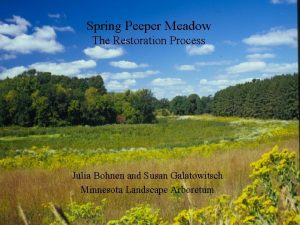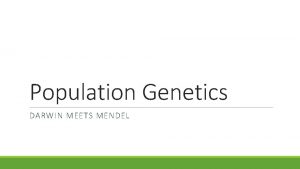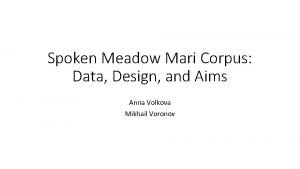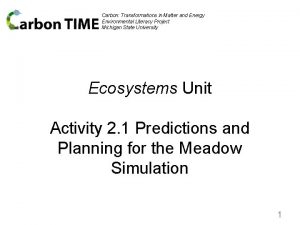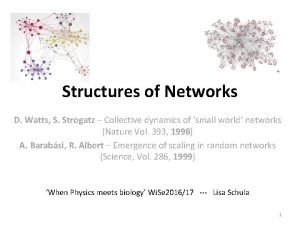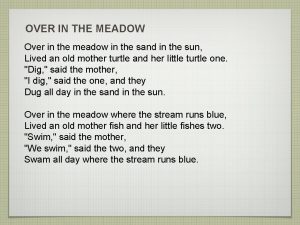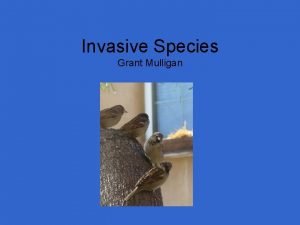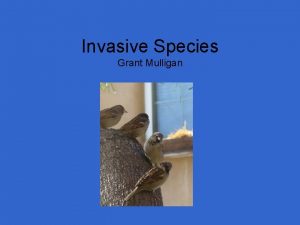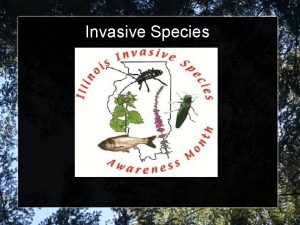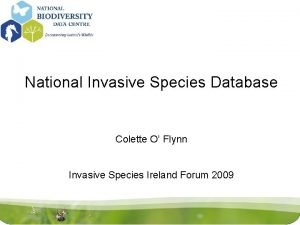Invasive PlantPollinator Dynamics in Meadow Networks Oregon State
















- Slides: 16

Invasive Plant-Pollinator Dynamics in Meadow Networks Oregon State University Eco. Informatic Summer Institute 2013 Noelle Patterson

Introduction ▪ Pollination Networks: A representation of the complex web of interactions between two distinct groups: plants and pollinators. ▪ Pollination networks were studied in fifteen montane meadows in the HJ Andrews Experimental Forest region. ▪ Pollination networks here include both native and invasive species. ▪ Common invasive insect: Apis mellifera (European honeybee) ▪ Common invasive plant: Hypericum perforatum (St. John’s wort)

Study #1 Comparison of nonnative Apis mellifera and native Bombylius major Apis mellifera on Gilia capitata Bombylius major

-Apis mellifera interactions reflect logistic growth. The %50 line corresponds with a G. capitata stem count of 333. 6. -92. 1% of Bombylius major interactions were with Gilia capitata; this is modeled in logistic regression poorly.

-In terms of Gilia capitata use, both Apis and Bombylius occupy the same niche. -However, Apis mellifera pollinate in much higher numbers and have a broader overall diet than Bombylius. Interaction Frequency with Gilia capitata 500 Number of interactions 450 400 350 A. mellifera 300 250 200 B. major 150 100 50 0 0 1 2 3 Round 4 5 6 7

Why so many honeybees? ▪ Apis mellifera are a domesticated species whose population is supported by outside human help, giving them an advantage over competition. ▪ But- Bombylius major is a parasite of solitary ground nesting bees. ▪ Outside Apis mellifera impacts… harmful or beneficial?

Study #2 Hypericum perforatum and Bombus species ▪ Hypericum perforatum (St. John’s wort) is a weedy plant native to Europe, W. Asia, and N. Africa which has become invasive in many areas including the Western Cascades. ▪ Although many nonnative plants in the HJA are restricted to roadsides, H. perforatum was found in three meadows from the 2011 sites. ▪ H. perforatum is a popular food source for bumblebees in the late summer season.

Bombus-Hypericum Interactions ▪ A strong correlation Proportion Hypericum interactions 1. 2 1 0. 8 R 2 = 0. 7939 0. 6 0. 4 0. 2 0 0 -0. 2 50 100 Hypericum flower count 150 200 exists between the amount of H. perforatum in the meadows and the proportion of pollination visits Bombus made to H. perforatum. ▪ Point: Bombus species appear to have a preference for invasive Hypericum perforatum

Good news: the variety of Bombus plant partners does not decrease due to H. perforatum presence. Percentage of available flower species used Bombus Flower Exploitation 0. 7 0. 6 Meadows with Hypericum 0. 5 0. 4 0. 3 Nearby meadows without Hypericum 0. 2 0. 1 0 4 5 Round 6 The percentage of available flower species pollinated by Bombus is found in each round as an average of meadows with H. perforatum and neighboring meadows without H. perforatum.

Bumblebees: following the flower? Bombus presence Number of Bombus interactions 140 Hypericum appears in meadows 120 100 Meadows with Hypericum Meadows near Hypericum 80 60 40 20 0 0 1 2 3 Round 4 5 6 7 During rounds 4 and 5 when H. perforatum is abundant, significantly more Bombus are found in meadows containing or nearby H. perforatum.





Conclusion ▪ Invasive species such as Apis mellifera and Hypericum perforatum have important roles within the pollination networks at the HJ Andrews forest. ▪ Apis mellifera is an important pollinator, but its volume of interactions may present competition to insects with overlapping niches like Bombylius major. ▪ Hypericum perforatum has become an significant part of late season Bombus diets and could affect their distribution and where they winter over. ▪ Much work must still be done exploring the relationships between insects, plants, and the entire network to gain a better understanding of these rich ecosystems.

Thank you To the EISI mentors who made this summer possible and to my great pollinator crew!
 Virtual circuit network and datagram network
Virtual circuit network and datagram network Backbone networks in computer networks
Backbone networks in computer networks Fuller meadow
Fuller meadow Julia bohnen
Julia bohnen A windstorm blows in hundreds of seeds from a nearby meadow
A windstorm blows in hundreds of seeds from a nearby meadow Spanish dancer jump rope song
Spanish dancer jump rope song Rectory meadow surgery
Rectory meadow surgery Cardiopathie de meadow
Cardiopathie de meadow I am a mountain at night meadow at day
I am a mountain at night meadow at day Meadow mari
Meadow mari In the article about the memory jungle the meadow
In the article about the memory jungle the meadow Frank meadow sutcliffe
Frank meadow sutcliffe Meadow mmo
Meadow mmo Environmental literacy
Environmental literacy Collective dynamics of small world networks
Collective dynamics of small world networks Mecop
Mecop Osas test administration manual
Osas test administration manual



